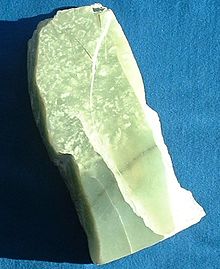| Jade | |
|---|---|
 Unworked jade | |
| General | |
| Category | Mineral |
| Crystal system | Monoclinic |
| Identification | |
| Color | Virtually all colors, mostly green |
| Crystal habit | Intergrown grainy or fine fibrous aggregate |
| Cleavage | None |
| Fracture | Splintery |
| Tenacity | Brittle |
| Mohs scale hardness | 6–7 |
| Diaphaneity | Translucent, opaque |
| Specific gravity | 2.9–3.38 |
| Refractive index | 1.600–1.688 |
| Birefringence | 0.020–0.027 |
| Pleochroism | Absent |
| Dispersion | None |

Jade is an umbrella term for two different types of decorative rocks used for jewelry or ornaments. Jade is often referred to by either of two different silicate mineral names: nephrite (a silicate of calcium and magnesium in the amphibole group of minerals), or jadeite (a silicate of sodium and aluminum in the pyroxene group of minerals).[1] Nephrite is typically green, although may be yellow, white or black. Jadeite varies from white or near-colorless, through various shades of green (including an emerald green, termed 'imperial'), to lavender, yellow, orange, brown and black. Rarely it may be blue. Both of these names refer to their use as gemstones, and each has a mineralogically more specific name. Both the amphibole jade (nephrite) and pyroxene jade are mineral aggregates (rocks) rather than mineral species. Nephrite was deprecated by the International Mineralogical Association as a mineral species name in 1978 (replaced by tremolite).[2] The name "nephrite" is mineralogically correct for referring to the rock. Jadeite, is a legitimate mineral species, differing from the pyroxene jade rock. In China, the name jadeite has been replaced with fei cui, the traditional Chinese name for this gem that was in use long before Damour created the name in 1863.[3]
Jade is well known for its ornamental use in East Asian, South Asian, and Southeast Asian art. It is commonly used in Latin America, such as Mexico and Guatemala. The use of jade in Mesoamerica for symbolic and ideological ritual was influenced by its rarity and value among pre-Columbian Mesoamerican cultures, such as the Olmecs, the Maya, and other ancient civilizations of the Valley of Mexico.
Jade is classified into three main types: Type A, Type B, and Type C. Type A jade refers to natural, untreated jadeite jade, prized for its purity and vibrant colors.[4] It is the most valuable and sought-after type, often characterized by its vivid green hues and high translucency. Type A jade is revered for its symbolism of purity, harmony, and protection in various cultures, especially in East Asia where it holds significant cultural and spiritual importance. Types B and C have been enhanced with resin and colourant respectively.
- ^ Eiland, Murray (2000). "Jade Is a State of Mind". Rock and Gem. 30 (6): 58–59 – via academia.edu.
- ^ Leake, B.E. "Nomenclature of amphiboles" (PDF). American Mineralogist. 63 (11–12): 1023–1052. Retrieved 5 December 2023.
- ^ Lotus Gemology. "From Fei Cui to Jadeite and Back • Questions and Answers". Lotusgemology.com. Lotus Gemology. Archived from the original on 5 December 2023. Retrieved 5 December 2023.
- ^ "What is Type "A" Jade?". 3 March 2023.